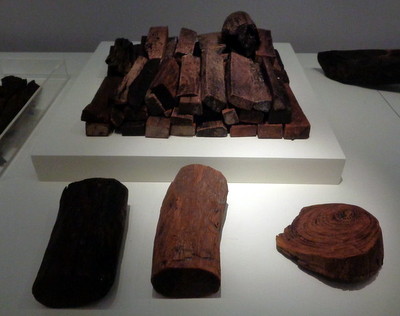Sandalwood
- Japanese: 白檀 (byakudan)
Sandalwood is an aromatic wood prized throughout East Asia for its use in architecture, sculpture, and incense since at least the 8th century. It was among the major luxury trade goods imported from Southeast Asia, and in the 18th-19th centuries from the Pacific Islands via European and American traders.
One large piece of sandalwood, known as the ranjatai, was held in the Imperial Shôsôin treasury since the 8th century. Pieces were broken off from time to time for use by the Imperial Household or members of the Imperial family. Ashikaga Yoshimasa and Oda Nobunaga were the only figures outside of the Imperial family to be granted access to pieces of this famous and treasured ancient piece of incense wood.[1]
In the Edo period, sandalwood was imported via the Chinese in Nagasaki, among other sources, along with other luxury goods such as tortoiseshell and ivory. Meanwhile, as the trans-Pacific trade in furs from the Pacific Northwest died down in the 1810s-1820s, and as China continued to show little interest in most Western goods other than silver, American and other traders hit upon sandalwood as a product they could sell in China, thus allowing them access to the profitable China trade. American and other Western merchant ships thus began trading in sandalwood from Hawaii, Fiji, the New Hebrides, and elsewhere in the Pacific, selling European and Chinese luxury goods to Pacific chiefs and others in exchange. Sandalwood quickly became one of the most prominent and influential trade goods for many Pacific Island economies, hitting its peak in the 1820s.
References
- Marsall Sahlins, "Cosmologies of Capitalism," Nicholas Dirks and Sherry Ortner et al. (eds.), Culture/power/history: a reader in contemporary social theory, Princeton University Press (1993), 431-433.
- ↑ Morgan Pitelka, Spectacular Accumulation, University of Hawaii Press (2016), 45-46, 183n14.
